Bernard Parham, chess innovator, passes away
Bernard Parham I, the 1967 Indiana State Champion and creator of the Matrix Chess System, has passed away. His son Bernard II relayed the news to The Chess Drum, “Resigned against diabetes on Wednesday, June 19th—one day after reaching his 58th wedding anniversary.” Born on October 30, 1946, to Eddie and Kathleen Parham, Bernard married Lugenia (White) on June 18, 1966, in Marion, Indiana. They met at Crispus Attucks High School in Indianapolis.
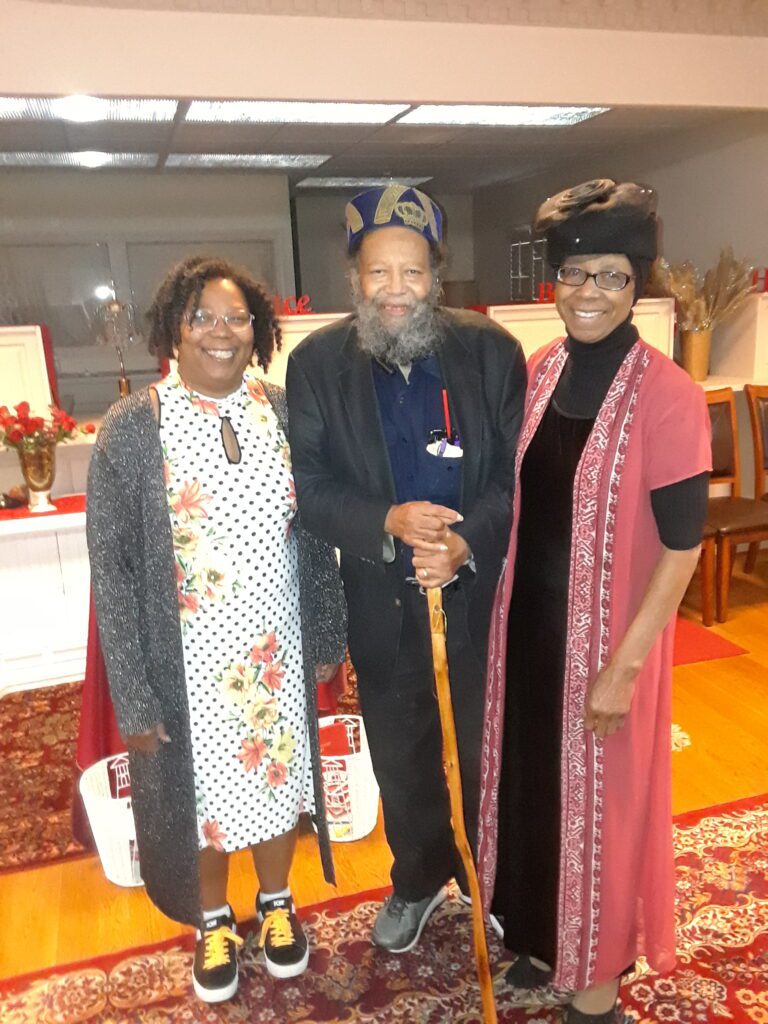

Bernard Parham with wife Lugenia (magenta outfit) and children, Lugenia and Bernard II
Photo courtesy of Bernard Parham II
Parham, who became a National Master in 1975 (not 1992 as indicated by USCF), became famous for the “Matrix System,” which postulated geometric routes toward the king to deliver the quickest checkmate. One of the main ideas of The Matrix is the “Parham Attack,” which comes from 1.e4 e5 2.Qh5! At first glance, many would see it as a beginner’s attempt at the “Scholar’s Mate,” but he has a more nuanced view of the opening. He has published his thoughts in a manual, drawing keen interest on lichess.org, chessgames.com, and chess.com.
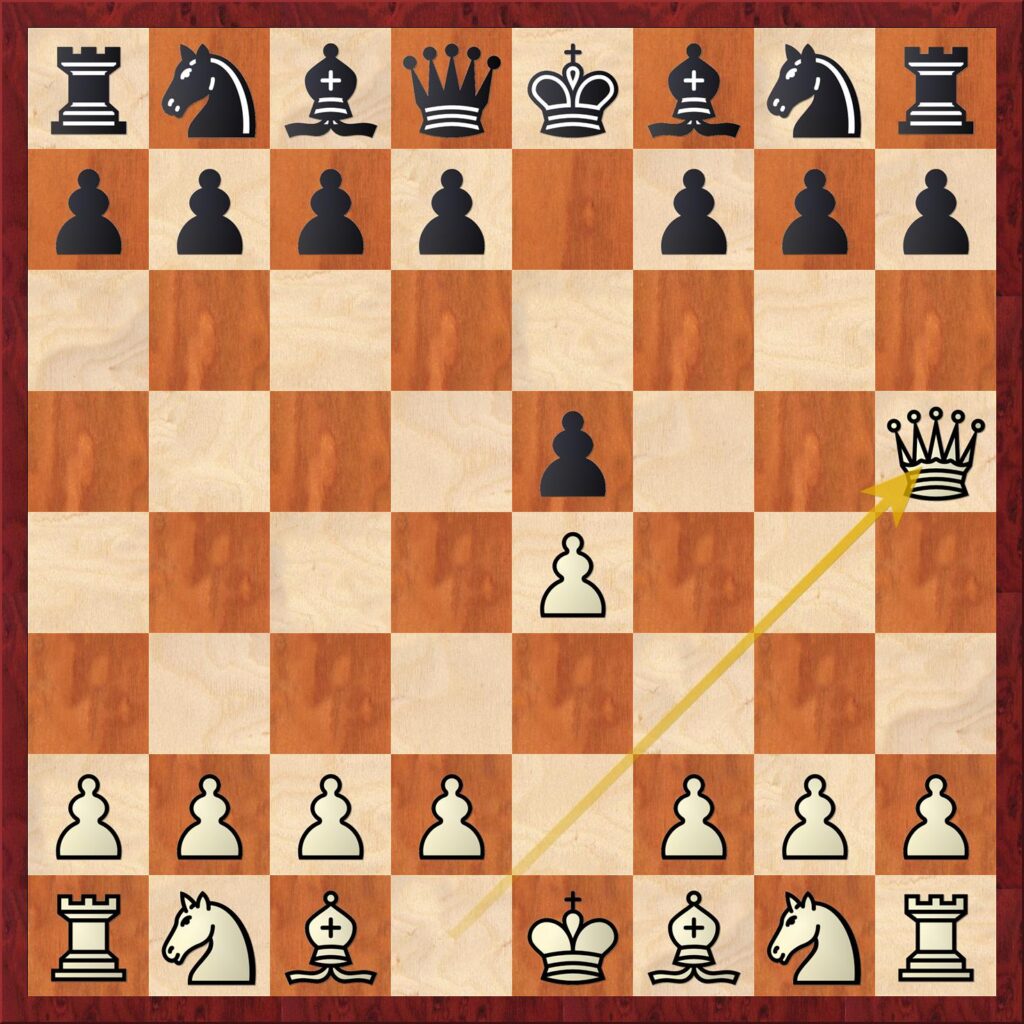
Parham was a lifetime resident of the “Hoosier State” and a contemporary of two African-American legends, Emory Tate and Leroy Muhammad. Tate was a six-time Indiana state champion and legendary tactician, while Muhammad spent his glory years as a young phenom in St. Louis before settling in Gary, Indiana. These three made wonderful contributions to Black chess history.
What is the Matrix System?
When listening to Parham explain the Matrix concepts, the ideas may seem bizarre to a chess purist. Some of the Matrix theories were that the queen was only worth six points and the bishops and rooks were equal due to movement on two geometric planes. This value assessment seems predicated on keeping the pieces on the board. The knight is eight points because it can command control in all directions, creating a diamond.
While studying vector analysis and physics at Purdue University, long-time Indiana Master Bernard Parham discovered a relationship between these higher sciences and chess. In 1965, he developed his “Matrix” System, which is based on the understanding of geometric patterns and vectors on the 8X8 matrix.
Daaim Shabazz, “Bernard Parham: Creator of the Matrix System,” The Chess Drum, 2 June 2003
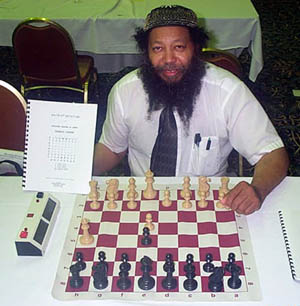
Bernard Parham showing his manual on the Matrix System during the 2003 World Open.
Photo by Daaim Shabazz/The Chess Drum
Obviously, his ideas go against normal principles of “don’t bring your queen out early.” We are taught not to bring our queens out, yet one of the first things we learn is to make a quick checkmate with the queen. Ironically, the Center Counter once had a horrible reputation. Today, it is considered a respectable opening and has been employed on occasion by world-class Grandmasters. Magnus Carlsen has also proved that just about any opening is playable.
“There was a time when many of today’s popular openings were considered nothing.”
Interestingly, the queen is the most important piece in the Matrix system in that it moves on the second move to create immediate threats. Parham would shock many strong players with this system. The Chess Drum interviewed Parham at the 2003 World Open, and he gave interesting insights. In the 2003 interview, he explained his way of calculating variations.
As the Queen and other pieces move across the board, the permutation of possibilities increase. Parham has created an interesting way of calculating variations on the board. He reduces this concept into two factors: Attackers and Defenders. Thus, the amount of permutations on any given move is defined by the formula (A!D!=P). For example, (2!2!=4) means when there are two attackers and two defenders then there are four possible move sequences from which a player can pick to attack. Thus, a position in which there are three attackers and three defenders, there are 36 move sequences (3!3!=36).
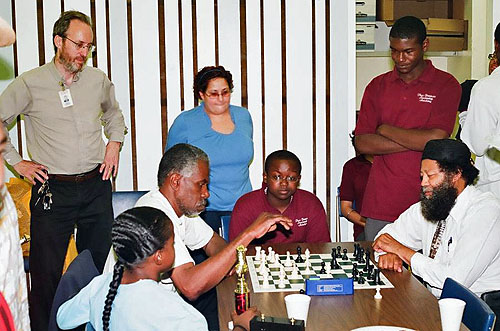
Sam Ford playing Bernard Parham in a blitz battle during a tribute to Parham at the Gary Public Library. Photo by Gary Public Library
The Origin of the Matrix Theory
How did the system come about? No, it did not borrow from the 1999 sci-fi thriller The Matrix. I wrote about the theory’s origins in the aforementioned interview.
Back in the 60s, an inquisitive young teen named Bernard Parham strolled through Indianapolis’ Douglass Park and something he saw intrigued him. There were men playing chess who he would come to learn were “street hustlers.” After watching over a period of time, young Parham noticed that the player who brought the Queen out the earliest won an overwhelming majority of the games. He would return to the park on a regular basis and watched their play with interest. Parham began copying down accounts of these games. A few years later, he would formally learn chess, but those lessons he learned in the park left an indelible impression.
Parham would graduate from Crispus Attucks High School and win a scholarship to Purdue University to study math and physics. It was in a physics class that he recognized a connection between chess and vector analysis. He was 18 years old at the time and would begin to refine his thoughts and eventually came up with a system of chess understanding called the “Matrix System.” Three years later, he would then burst onto the scene and win the 1967 Indiana State title with his revolutionary ideas. He later became a National Master known widely for the “Parham Attack” and brute tactical style.
Below is the first master-level game with 1.e4 e5 2.Qh5. The other appeared to be rank amateurs going all the way back to the first instance in 1905!
Nakamura (and others) trot out the Parham Attack!
The Parham Attack gained popularity when Hikaru Nakamura played it at the 2005 Sigeman Chess Tournament and got a playable position against strong Grandmaster Krishnan Sasikiran.
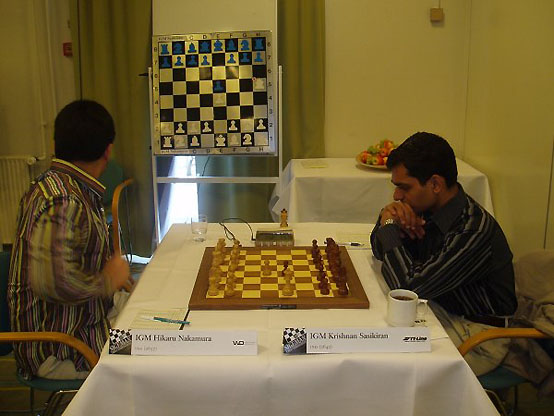
He lost a tough battle after spurning a draw, but he had started a discussion and proceeded to play hundreds of games at the Internet Chess Club with 2.Qh5. Almost 20 years later, Indian Grandmaster S.B. Sethuraman revisited Parham’s system citing Nakamura-Sasikiran.
Bernard Parham of Indianapolis is the first master-level player known to have advocated this line. He is known for his eccentric theories which he calls the "Matrix System".https://t.co/wvXPheCqNr pic.twitter.com/N9BTWjzcq7
— Chessable (@chessable) October 25, 2020
Nakamura also played it against Nikolai Mitkov at Maurice Ashley’s HB Global Chess Challenge.
Surprisingly, there are almost 300 games in Megabase of 1.e4 e5 2.Qh5. Nakamura has played it in blitz games, but there have been a couple of games by Magnus Carlsen! Algerian Grandmaster Bilel Bellachene has the most games of any player with the opening.
One has a right to be skeptical of the system because it goes against what we are taught as chess players. However, Parham has left us with the thought of viewing chess through a different lens. Can a bishop be equal to a rook? Of course. This is especially true in the early stages of the game when the rook is hemmed in the corner or blocked by pawns. It may also be interesting that K+R cannot (with best play) defeat K+B.
“I find chess endlessly invigorating. Chess keeps your mind active. You stay cognitive.”
Ingrid Cummings’ “Chess is More,” Indianapolis Monthy, January 2007, 70-75.

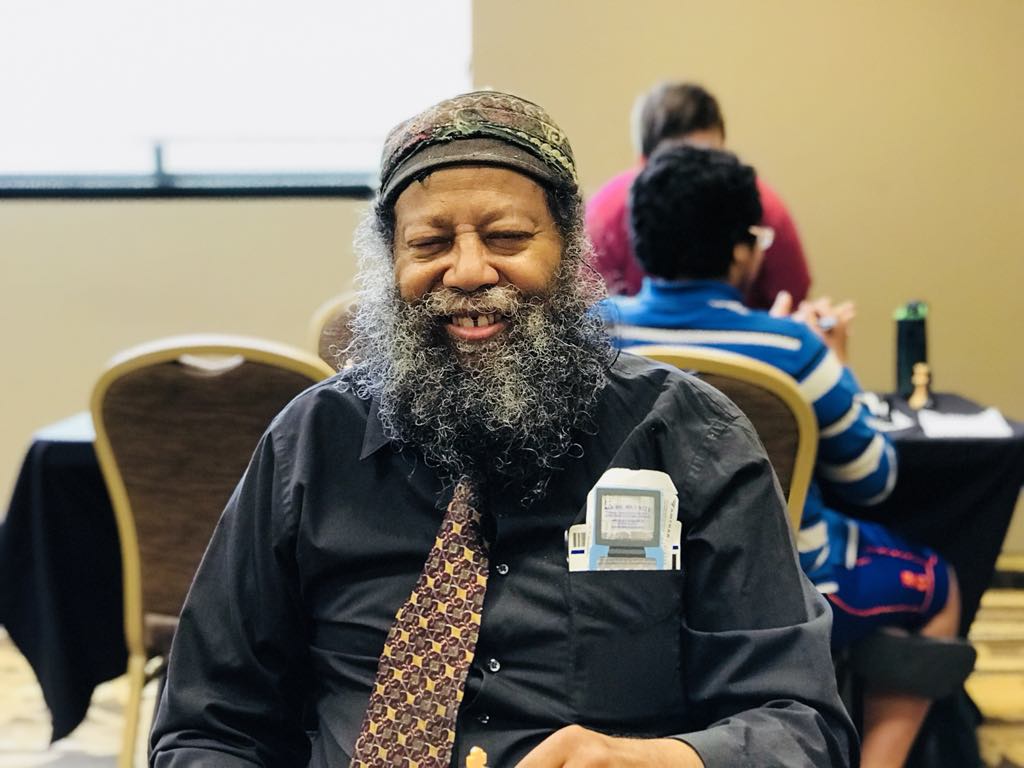
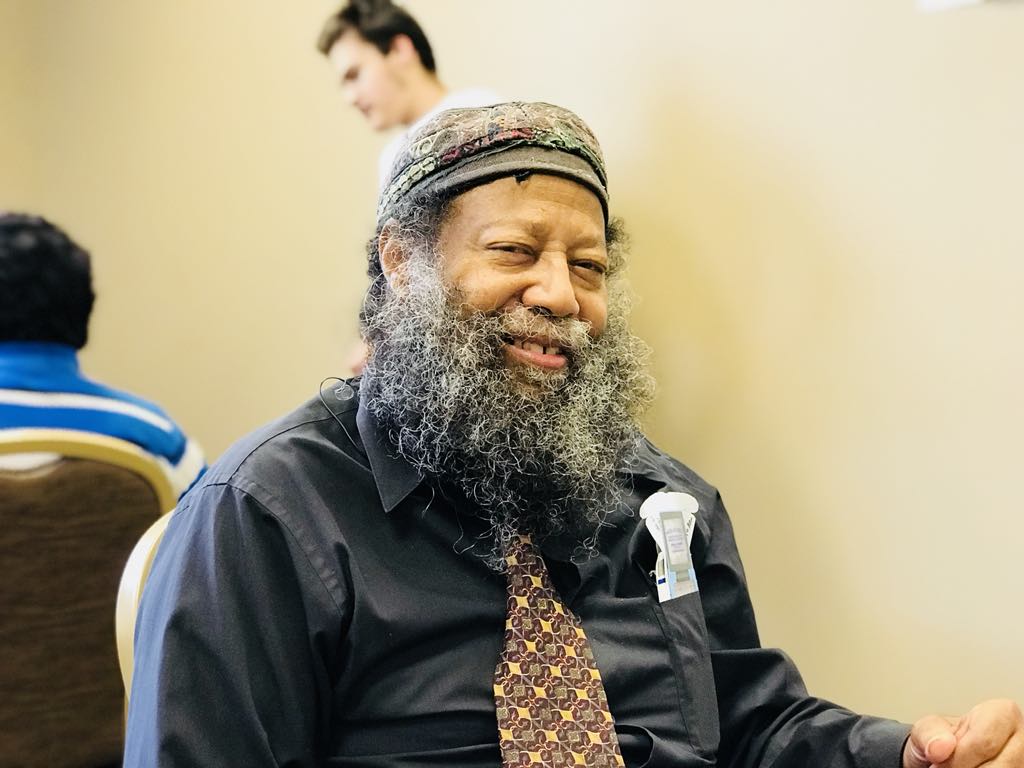
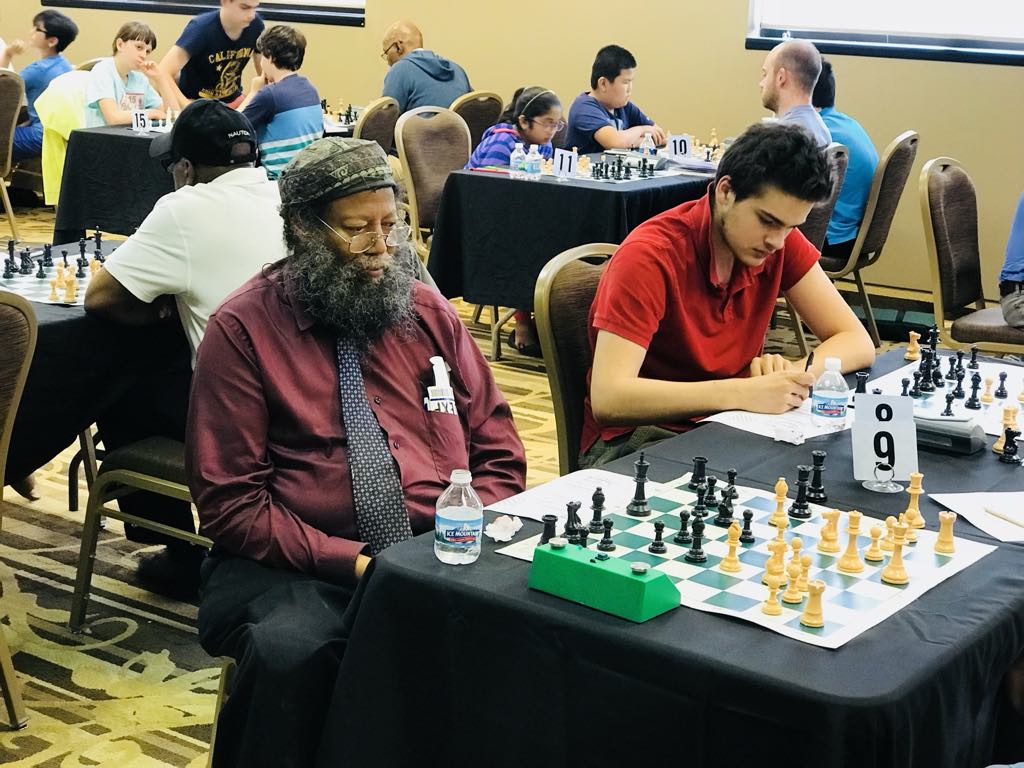
Photos by Nathan Kelly Photography
Parham’s Legacy
Bernard Parham’s ideas have a couple of merits. It is certainly unique, and while he may not have been a top-level Grandmaster, others can refine his ideas. He has left us a mode of thinking about piece play, geometric patterns, and a new way of viewing the chessboard.
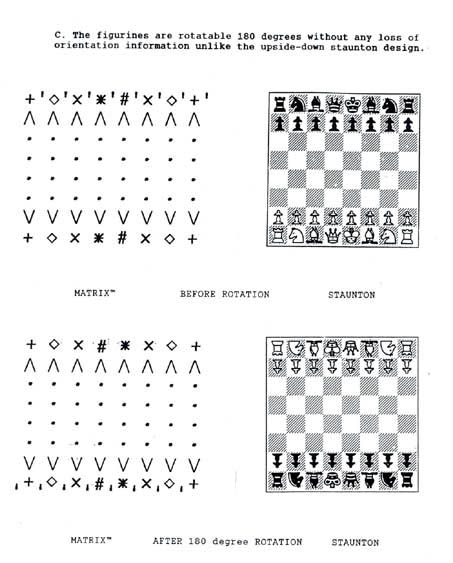
On this 8×8 matrix, he also created a new way to take chess notation. In one of the pieces on The Chess Drum, it reads,
Another component of the Matrix Notation System™ is a rather ingenious attempt to maintain the geometric orientation of the 8X8 chess board matrix. Each piece is represented by its geometric movement as opposed to a letter. This also makes the game score easier to follow without the sight of a board.
On 11 October 1995, Parham received a letter from the United States Chess Federation approving the use of the Matrix Notation in U.S. tournaments. Whether this notation system will gain wider practical use for illustrating chess positions remains to be seen; however, its inventiveness is admirable and Parham is to be commended for his revolutionary effort at teaching one aspect of chess science.


Parham sketched these diagrams during the 2003 interview with The Chess Drum to explain his system. The diagrams also explain his notation symbology. Photo by Daaim Shabazz/The Chess Drum
Reflections
This writer knew Parham from Chicago tournaments, and he was always very approachable and in a good mood. We played once. Ironically, I got a Matrix position against him as white, with the game starting 1.e4 e5 2. Nc3 Nc6 3.Bc4 Bc5 4.Qg4!? Kf8 5.Qf3. Parham mentioned to me that this was part of his Matrix system. I lost the game after unsuccessfully sacrificing a couple of pieces to get to his king. I almost broke through, but he held his composure and always had a calm demeanor while playing.
I also witnessed his Parham Attack in action as he played against Vlad Dima on the board next to me. While I had my own game to play, it was a joy to watch this game unfold. Dima had such a shellshocked look on his face after the game.
Here is a father-son battle at the Purdue Open… a lot of fun!!
So this is the beauty of what Parham has left us. His son Bernard II has been a loyalist of the Matrix System, and he can be seen at tournaments using the cryptic notion system. He was a successful scholastic player, winning the 1994 National K-12 Championship (Grade 12) using the Parham Attack. At the 2003 World Open Bernard II told The Chess Drum that he had made some improvements and plays the system the best. Rest assured, the ancestor Parham’s legacy is safe, and we may see more theoretical debates on the Parham Attack.
Thank you for your contribution!
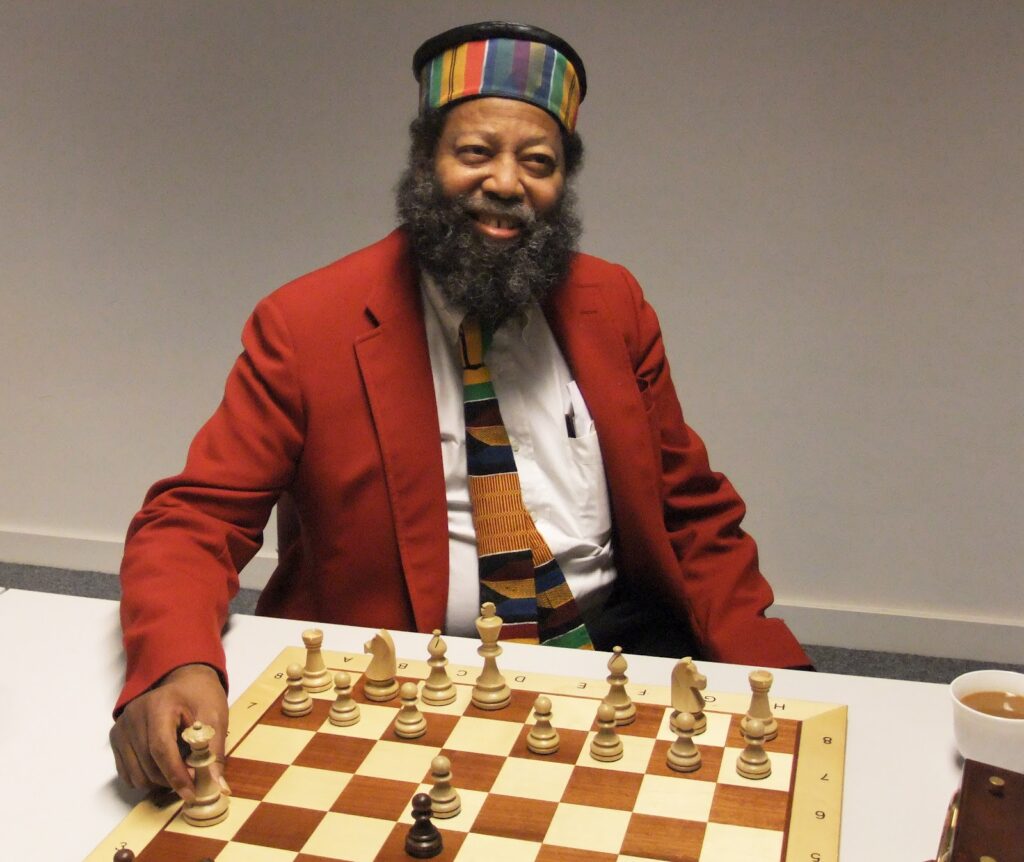
Bernard L. Parham I
October 30, 1946 – June 19, 2024

Sources
- Daaim Shabazz, “Indiana Jones meets ‘The Matrix’,” The Chess Drum, 22 April 2002.
- Daaim Shabazz, “Bernard Parham: Creator of the Matrix System,” The Chess Drum, 2 June 2002.
- Daaim Shabazz, “The Talking Drum featuring Bernard Parham,” The Chess Drum, 6 July 2003.
- Daaim Shabazz, “Matrix Reloaded? Parham Attack II,” The Chess Drum, 18 January 2004.
- Daaim Shabazz, “Nakamura dives into ‘The Matrix‘,” The Chess Drum, 23 April 2005.
- Sara Smith, “Chess Master passes his love of game to others,” The Exponent, 9 March 2010.
- Daaim Shabazz, “‘Matrix Man’ still at it!” The Chess Drum, 11 March 2010.
- Daaim Shabazz, “Indiana Chess moving forward!” The Chess Drum, 19 July 2010.
- “Bernard Parham,” EverybodyWiki.

Parham plays the wily master Erik Karklins. From the style, it appears as if Parham is playing white, but he is playing black. Karklins plays in the Matrix style. Take a look at this crazy game! Karklins died at the ripe age of 102.
The Fischer Mystery
Did Bernard Parham I play Bobby Fischer in a simutaneous exhibition in 1964? This game below against Fischer is listed as played by “Fenner Parham” in most sources. Fenner was said to be a relative of Bernard I although Bernard II has denied this on chessgames.com. https://www.chessgames.com/perl/chessgame?gid=1255160
There have been interesting discussions here… https://www.wikiwand.com/en/Talk:Danvers_Opening and here… https://www.chessgames.com/perl/chessgame?gid=1255160
Talked to Bernard II this morning, and he asserts that the Matrix System can also be employed in Fischer Random, and there has been too much emphasis on the move 2.Qh5. The idea is that the squares are more important than the pieces’ initial placement.